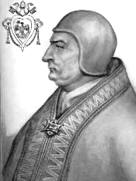 Clement
IV, né Gui Faucoi le Gros (Engl.
Guy Foulques the Fat or It.
Guido le Gros) (Saint-Gilles-du-Gard,
November 23, year uncertain – Viterbo, November
29, 1268), was elected pope February 5, 1265, in
a conclave held at Perugia that took four
months, while cardinals argued over whether to
call in Charles of Anjou, the youngest brother
of the king of France, to carry on the papal war
against the last of the house of Hohenstaufen.
Clement
IV, né Gui Faucoi le Gros (Engl.
Guy Foulques the Fat or It.
Guido le Gros) (Saint-Gilles-du-Gard,
November 23, year uncertain – Viterbo, November
29, 1268), was elected pope February 5, 1265, in
a conclave held at Perugia that took four
months, while cardinals argued over whether to
call in Charles of Anjou, the youngest brother
of the king of France, to carry on the papal war
against the last of the house of Hohenstaufen.Guy had been an unlikely candidate for holy orders: widowed and the father of two young women, before taking orders he had been successively a soldier and a lawyer, and in the latter capacity had acted as secretary to Louis IX of France, to whose influence he was chiefly indebted for his elevation. Upon the death of his wife, he followed his father's example and gave up secular concerns for the Church. His rise in the church was rapid: in 1256, he was Bishop of Le Puy, in 1259, Archbishop of Narbonne and in December 1261, he was the first cardinal created by Urban IV, in the see of Sabina. He was the papal legate in England 1262–1264.
At this time the Holy See was engaged in a conflict with Manfred, the illegitimate son and designated heir of Frederick II of Hohenstaufen, but whom papal loyalists, the Guelfs, called "the usurper of Naples". Clement, who was in France at the time of his election, was compelled to enter Italy in disguise. He immediately took steps to ally himself with Charles of Anjou, his erstwhile patron's brother, the impecunious French claimant to the Neapolitan throne. Charles allowed the Pope to be his feudal overlord (a bone of contention with the Hohenstaufen) and was crowned by cardinals in Rome, where Clement, permanently established at Viterbo, dared not venture, the Ghibelline party was so firmly in control. Then, fortified with papal money and supplies, Charles marched into Naples. "Papal legates and mendicant friars appeared upon the scene, preaching a formal crusade, with the amplest indulgences and most lavish promises" (Catholic Encyclopedia). Among the Italians who failed to see any nobler crusading purpose in the conflict was Dante (Inferno, Canto xxvii). Having defeated and slain Manfred in the great Battle of Benevento, Charles established himself firmly in the kingdom by the conclusive Battle of Tagliacozzo, in which Conradin, the last of the house of Hohenstaufen, was taken prisoner. Clement is said to have disapproved of the cruelties committed by his protegé, and there seems no foundation for the statement by Gregorovius that Clement became an accomplice by refusing to intercede for the unfortunate Conradin whom Charles had beheaded in the marketplace of Naples.
Within months Clement was dead too, and buried at Viterbo. Owing to unbridgeable divisions among the cardinals, the papal throne remained vacant for nearly three years.
Clement's private character was praised by contemporaries for his asceticism, and he is especially commended for his indisposition to promote and enrich his own relatives. He also did himself great honour by his encouragement and protection of Roger Bacon. He was buried at Viterbo, where he had resided throughout his pontificate.

